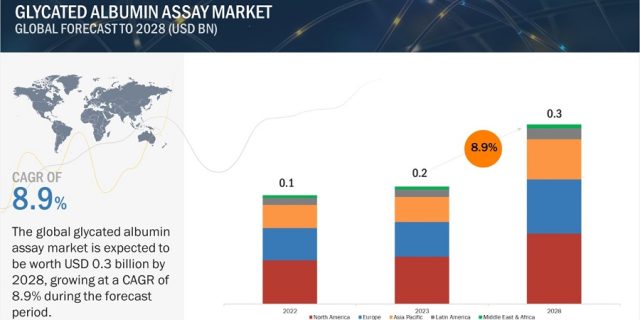
The global glycated albumin assay market is projected to experience robust growth in the coming years, escalating from $0.2 billion in 2023 to $0.3 billion by 2028. This upward trajectory, with a projected compound annual growth rate (CAGR) of 8.9%, can be attributed to several key driving forces.
Foremost among these is the alarming rise in the prevalence of diabetes worldwide. As this chronic metabolic disorder becomes increasingly widespread, the demand for accurate diagnostic tools, such as glycated albumin assays, is experiencing a corresponding surge. These assays play a crucial role in monitoring and managing diabetes by measuring the glycated portion of albumin in the blood, providing valuable insights into long-term glycemic control.
Download a PDF Brochure: https://www.marketsandmarkets.com/pdfdownloadNew.asp?id=265553363
Additionally, governmental initiatives aimed at promoting disease diagnosis and raising awareness about diabetes management are contributing to the market’s expansion. As public health campaigns highlight the importance of early detection and effective treatment, the utilization of glycated albumin assays is poised to increase substantially.
However, the market’s growth is not without its challenges. One significant hurdle is the unfavorable reimbursement landscape, with inadequate coverage from Medicare and private health insurers failing to fully reflect the actual cost and clinical value of these diagnostic tests. This financial barrier could impede the widespread adoption of glycated albumin assays, necessitating concerted efforts to address reimbursement policies.
On a positive note, the market is expected to benefit from the rising investments in healthcare and life sciences research, particularly in emerging economies such as India, South Korea, Brazil, and Mexico. These regions, characterized by high disease prevalence, substantial patient populations, and improving healthcare infrastructure, present lucrative opportunities for the glycated albumin assay industry.
Concurrently, navigating the evolving regulatory landscape poses a formidable challenge. Stringent legal requirements and increasing scrutiny from regulatory bodies, such as the US Food and Drug Administration (FDA) and the European Union (EU), demand continuous adaptation and compliance from manufacturers. Failure to meet these standards could impede market growth and hinder the introduction of innovative diagnostic solutions.
Looking ahead, the glycated albumin assay market is poised for substantial growth, driven by the escalating demand for effective diabetes management tools and supported by favorable demographic trends. However, addressing the reimbursement conundrum and navigating the intricate regulatory environment will be crucial for unlocking the market’s full potential and ensuring widespread access to these essential diagnostic tests.


